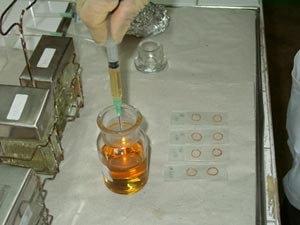
Animal Rabies diagnosis & Research laboratory
Animal Rabies diagnosis & Research laboratory
Aetiology
Aetiology
Rabies is a viral disease of all warm-blooded mammals with an almost worldwide distribution. The virus is present in the saliva and nervous system tissue of infected animals. Disease transmission is invariably via the bite or through of the infected fluid with cuts or wounds in skin or mucous membranes that is excreting the virus in its saliva. Rarely; the infection can be transmitted through the respiratory system when the virus is inhaled. The mortality rate is close to 100 % .Once clinical signs appear in the bite victim, death from rabies is nearly always the outcome. Worldwide, probably more than 50 000 human deaths from the disease occur annually as a result of bites from rabies-infected dogs. In nature, no fish, reptiles, or birds have been found to be rabid.
Classification
Rabies viruses are of the Order
Mononegavirales ,
Family
Rhabdoviridae , genus Lyssavirus .
The
Rhabdoviridae are characterized by a negative-sense genome
of single-stranded RNA and the family is divided into two genera,
Vesiculovirus ,
which includes the viruses causing vesicular stomatitis and antigenically
related viruses, and
Lyssavirus , which includes rabies and
the rabies-related viruses
|
Rhabdoviridae |
|
Vesiculovirus |
Lyssavirus |
|
Vesicular stomatitis Indiana (VSI) Vesicular stomatitis New Jersey (VSNJ) Vesicular stomatitis Alagoas (VSA) |
Rabies Lagos bat virus Mokola virus |
|
about 50 less important viruses |
Duvenhage virus Duvenhage virus European bat lyssavirus I |
|
European bat lyssavirus II Australian lyssaviruses |
Temperature
|
Temperature ( C) |
Survival |
|
- 20 |
Years, especially if preserved in glycerol |
|
4 22 |
Months Weeks, particularly in brain tissue |
|
37 56 |
1–2 weeks < 30 min |
Chemical
Relatively stable at pH 5–8. Grows better in cultures slightly on the alkaline side of neutrality. Sensitive to lipid solvents (soap solution, ether, chloroform and acetone, although acetone does not completely inactivate the virus), 40–70% ethanol, iodine preparations and quaternary ammonium compounds. Disinfectants which contain iodine are particularly useful for decontamination of laboratory instruments and surfaces, but because of the contained acid, contact with skin should be avoided.

Environmental conditions
The virus is sensitive to ultraviolet light, but has frequently been isolated from the brains of animals in the field, even when they are decomposed. The virus is resistant to drying and can withstand repeated freezing and thawing.

